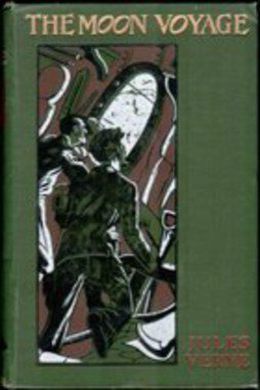
-
EPUB 370 KB
-
Kindle 465 KB
-
Support epubBooks by making a small $2.99 PayPal donation purchase.
Description
This [1877 Ward Lock] edition includes both From the Earth to the Moon and ‘Round the Moon, combined into one volume and without illustrations. A fully illustrated edition can be found here.
The Moon-Voyage is an amazing work of science-fiction by Jules Verne. The author has picturesquely depicted the efforts of the three astronomers of the American Gun club. Their goal of landing on the moon seemed far-fetched and the mockery of those around them fuelled their ambition. Truly astounding!
422 pages with a reading time of ~6.50 hours (105585 words), and first published in 1873. This DRM-Free edition published by epubBooks, 2009.
Community Reviews
There are currently no other reviews for this book.
Excerpt
On the 5th of October, at 8 p.m., a dense crowd pressed into the saloons of the Gun Club, 21, Union-square. All the members of the club residing at Baltimore had gone on the invitation of their president. The express brought corresponding members by hundreds, and if the meeting-hall had not been so large, the crowd of savants could not have found room in it; they overflowed into the neighbouring rooms, down the passages, and even into the courtyards; there they ran against the populace who were pressing against the doors, each trying to get into the front rank, all eager to learn the important communication of President Barbicane, all pressing, squeezing, crushing with that liberty of action peculiar to the masses brought up in the idea of self-government.
That evening any stranger who might have chanced to be in Baltimore could not have obtained a place at any price in the large hall; it was exclusively reserved to residing or corresponding members; no one else was admitted; and the city magnates, common councillors, and select men were compelled to mingle with their inferiors in order to catch stray news from the interior.
The immense hall presented a curious spectacle; it was marvellously adapted to the purpose for which it was built. Lofty pillars formed of cannon, superposed upon huge mortars as a base, supported the fine ironwork of the arches–real cast-iron lacework.
Trophies of blunderbusses, matchlocks, arquebuses, carbines, all sorts of ancient or modern firearms, were picturesquely enlaced against the walls. The gas, in full flame, came out of a thousand revolvers grouped in the form of lustres, whilst candlesticks of pistols, and candelabra made of guns done up in sheaves, completed this display of light. Models of cannons, specimens of bronze, targets spotted with shot-marks, plaques broken by the shock of the Gun Club, balls, assortments of rammers and sponges, chaplets of shells, necklaces of projectiles, garlands of howitzers–in a word, all the tools of the artilleryman surprised the eyes by their wonderful arrangement, and induced a belief that their real purpose was more ornamental than deadly.
In the place of honour was seen, covered by a splendid glass case, a piece of breech, broken and twisted under the effort of the powder–a precious fragment of J.T. Maston’s cannon.
At the extremity of the hall the president, assisted by four secretaries, occupied a wide platform. His chair, placed on a carved gun-carriage, was modelled upon the powerful proportions of a 32-inch mortar; it was pointed at an angle of 90 degs., and hung upon trunnions so that the president could use it as a rocking-chair, very agreeable in great heat. Upon the desk, a huge iron plate, supported upon six carronades, stood a very tasteful inkstand, made of a beautifully-chased Spanish piece, and a report-bell, which, when required, went off like a revolver. During the vehement discussions this new sort of bell scarcely sufficed to cover the voices of this legion of excited artillerymen.
In front of the desk, benches, arranged in zigzags, like the circumvallations of intrenchment, formed a succession of bastions and curtains where the members of the Gun Club took their seats; and that evening, it may be said, there were plenty on the ramparts. The president was sufficiently known for all to be assured that he would not have called together his colleagues without a very great motive.
Impey Barbicane was a man of forty, calm, cold, austere, of a singularly serious and concentrated mind, as exact as a chronometer, of an imperturbable temperament and immovable character; not very chivalrous, yet adventurous, and always bringing practical ideas to bear on the wildest enterprises; an essential New-Englander, a Northern colonist, the descendant of those Roundheads so fatal to the Stuarts, and the implacable enemy of the Southern gentlemen, the ancient cavaliers of the mother country–in a word, a Yankee cast in a single mould.
Barbicane had made a great fortune as a timber-merchant; named director of artillery during the war, he showed himself fertile in inventions; enterprising in his ideas, he contributed powerfully to the progress of ballistics, gave an immense impetus to experimental researches.
He was a person of average height, having, by a rare exception in the Gun Club, all his limbs intact. His strongly-marked features seemed to be drawn by square and rule, and if it be true that in order to guess the instincts of a man one must look at his profile, Barbicane seen thus offered the most certain indications of energy, audacity, and sang-froid.
At that moment he remained motionless in his chair, mute, absorbed, with an inward look sheltered under his tall hat, a cylinder of black silk, which seems screwed down upon the skull of American men.
